

World's biggest offshore windfarm planned off Scottish coast. The £4.5bn complex would have 339 turbines covering 300 square kilometres off Caithness.

Photograph: Christopher Furlong/Getty Images The world's biggest offshore windfarm could be built off the northern Scottish coast, after a scheme with enough capacity to power 40% of Scottish households was submitted for planning permission. The £4.5bn complex would have 339 turbines covering 300 square kilometres off Caithness, making it 50% bigger than the giant London Array scheme off Kent. It is expected to be the first in a series of deep water schemes under "Round 3" licensing. The renewable industry has hailed it as a watershed moment but warned these new deep water farms might only be fully realised if the government provides policy stability by pushing through its proposed Energy Bill. If we want food to remain cheap we need to stop putting it in our cars. Coverage of the US drought and the run-up in corn, soybean, and wheat prices has been extensive and welcome.
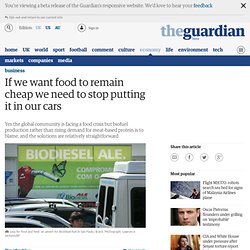
It has also been prone to the repetition of falsehoods and the perpetuation of myths about the causes of the food crisis – and the solutions. A recent Guardian article, "The era of cheap food may be over," is a case in point. Specifically, it perpetuates the myth that the main driver of food price increases is demand for meat in fast-growing developing countries. This effectively downplays the full impact of biofuels and ignores two problems underlying price volatility: financial speculation and the lack of publicly held food reserves. The era of cheap food may be over.
Maize on a drought-hit farm in Indiana.
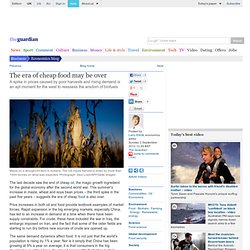
The US maize harvest is down by more than 100m tonnes on what was expected. Photograph: Saul Loeb/AFP/Getty Images. Illegal wildlife trading in internet's deepest, darkest corners. There are fewer than 1,000 Luristan newts left in the wild in Iran, yet they are illegally sold as pets.

Photograph: Barbod Safaei Mahroo/Lorestan Mountain Newt Conservation Plan. Why Britain's battle to bring down social inequality has failed. Danny Dorling has been readying himself for some indignant reactions in political circles to his latest book, unequivocally titled Injustice: Why Social Inequality Persists, and published as the election campaign is in full swing.
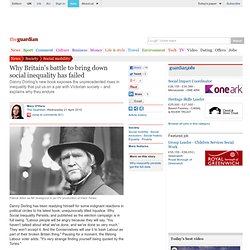
"Labour people will be angry because they will say, 'You haven't talked about what we've done, and we've done so very much.' Relationship violence 'normal' to disadvantaged British teens. Research into violence in relationships finds that some disadvantaged British youngsters now accept physical and sexual abuse as a normal part of partnerships.

The National Society for the Prevention of Cruelty to Children (NSPCC) funded researchers from the University of Bristol in examining the experiences of 82 youngsters aged from 13 to 18-years-old. The teenagers were considered disadvantaged because they were no longer in education and their number included convicted offenders and teenage parents. While the team behind the research admit that such a small sample cannot be considered representative of the wider population, they argue that their research suggests that violence is much more prevalent than has been previously thought. Of their study group, more than 50 percent of the girls had suffered sexual violence in a relationship; more than half also reported physical violence.
"Only through awareness can we start to reduce abuse which damages so many young lives. " Social Inequality and the New Elite. As South Africa Reels from Mine Shootings, Social Inequality Threatens to Undo the Post-Apartheid ‘Miracle’ Sixty years of change in India. This week marks the 60th anniversary of India's constitution.
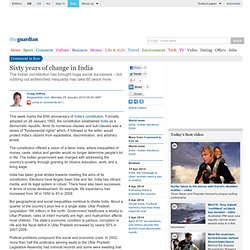
Formally adopted on 26 January 1950, the constitution established India as a democratic republic. Amid its numerous clauses and sub-clauses was a series of "fundamental rights" which, if followed to the letter, would protect India's citizens from exploitation, discrimination, and arbitrary arrest. Poverty and Rising Social Inequality in India. The issue of poverty keeps rearing its inconvenient head in India.
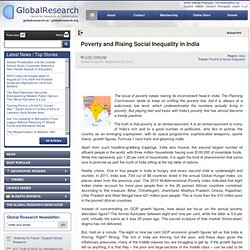
The Planning Commission tends to keep on shifting the poverty line, but it is always at a ludicrously low level, which underestimates the numbers actually living in poverty. But playing fast and loose with India’s poverty line has almost become a trendy pastime. The truth is that poverty is an embarrassment. It is an embarrassment to many of India’s rich and to a good number of politicians, who like to portray the country as an emerging superpower, with its space programme, sophisticated weaponry, sports towns, growth figures, Formula 1 race track and gleaming malls. Apart from such headline-grabbing trappings, India also houses the second largest number of affluent people in the world, with three million households having over $100,000 of investable funds.
Reality check. Instead of concentrating on GDP growth figures, how about we focus on the annual poverty alleviation figure? But, hold on a minute. What India and America have in common: Inequality. Editor's Note: Pranab Bardhan is Professor of Economics, University of California at Berkeley and the author, most recently, of Awakening Giants, Feet of Clay: Assessing the Rise of China and India.
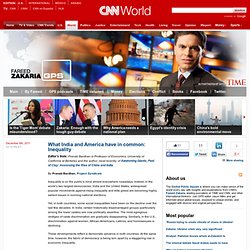
By Pranab Bardhan, Project Syndicate Inequality is on the public’s mind almost everywhere nowadays. Indeed, in the world’s two largest democracies, India and the United States, widespread popular movements against rising inequality and elite greed are becoming highly salient issues in looming national elections. Yet, in both countries, some social inequalities have been on the decline over the last few decades. In India, certain historically disadvantaged groups (particularly among the lower castes) are now politically assertive. These developments reflect a democratic advance in both countries. Generally, economic inequality is easier to justify than racism and other forms of invidious discrimination. There are two problems with this argument.